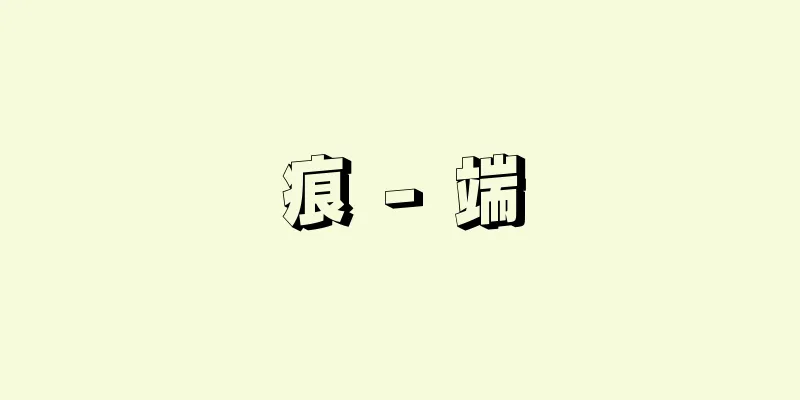Sports - Sports (English spelling)

|
"Sports is a culture common to all of humanity that is based on the enjoyment of spontaneous movement. Sports, which are played throughout one's life, contribute to enriching one's life and improving culture, and are essential for people to pursue happiness and live healthy and cultured lives. Furthermore, sports have the social value of contributing to the realization of a desirable society through people participating independently and voluntarily.' Article 1 of the Japan Amateur Sports Association (now the Japan Sport Association) Sports Charter (established in May 1986) states the significance and value of sports. This is a statement about amateur sports, but it can also be taken as a general statement about sports. As the etymological transition from deporatare (Latin), desporter (French), and disport (English) shows, sport was used to mean recreation or entertainment. Around the 15th century, it spread to English and became disport(u) and sporte, but eventually the initial sound disappeared and it became sport(s). In the 19th century, it was adopted into German and French, and is now used as a common language around the world. Incidentally, the synonym athletics refers to physical education and track and field events in the UK, and to sports in general in the US. [Yoshinori Suzuki] historySports are a culture that only humans possess, but if we look at the process of their formation, it is a historically clear fact that they were born from conflict and were destined to be used by politics as a means of conflict. On the other hand, some were held as religious events. When humans first appeared on Earth, sports were with them. Images of sports can be seen in murals of the ancient Orient, and in the excellent sculptures, paintings, and vase paintings of ancient Greece, which show that hockey, boxing, wrestling, and other sports have been played since ancient times. The foundations of sports were formed in ancient Greece, where faith and sports were combined in the form of festival games. Of the festival games held in various places as prayers to patron gods, the ancient Olympia is a typical example. Participants from all over Greece participated in the games, carrying the honor and glory of their city-states. The winners were only given a wreath of olive or laurel leaves as a tribute, but when they returned home after winning, they were given pensions and other benefits, and received the greatest possible mental and material treatment. In the Roman era, these games disappeared when Christianity became the state religion, and spectator sports became more popular. Gladiator games were held in the Colosseum in Rome, and chariot races were held in the Circus Maximus. These games, which were shown to the citizens, were called ludus (fun sports). After the fall of Rome and the beginning of the Middle Ages, sports spread from royalty to the general public. A typical example was a tournament in which knights on horseback stabbed each other with long spears, which cultivated the spirit of chivalry. Various hunting and falconry were also popular, but the most popular sport was jeu de paume (the prototype of tennis). Then soeur (a type of football) became popular, spread to England, and eventually developed into soccer and rugby. In England, sports were encouraged for the children of the aristocracy in the 16th and 17th centuries, and many modern sports were established one after another, eventually spreading all over the world. In America, baseball, basketball, and American football were born, but all of them were based on various sports that originated in England, with the play changed. Horse racing also became popular, and the Derby began in 1780. Skiing and judo, which developed without any connection to England, are rare exceptions. When the first modern Olympic Games were held in Athens in 1896, sports showed greater international reach, and sports, which had previously been the preserve of royalty and aristocracy, began to spread widely among the general public as economic and social systems developed. In Japan, sumo, the national sport, already existed in the mythological era, as can be seen in the description of the legend of the strength contest between Nomi no Sukune and Taima no Kehaya in the Nihon Shoki. During the Nara period, falconry, horse racing, dakyuu (ball-playing game), and kemari (ball-playing game), were practiced among the nobility, and after the Muromachi period, swordsmanship, jujutsu, archery, and spearmanship flourished. During the Edo period, these martial arts lost their practical value, but were strongly influenced by Confucianism, and many schools based on bushido were formed. However, most of these were practiced among a certain privileged class, which was in line with those in Europe. It was not until the Meiji period that modern sports from Europe and the United States were imported and sports became popular among the general public. Japan first participated in the Olympic Games at the 5th Games (Stockholm) in 1912 (Meiji 45). [Yoshinori Suzuki] Organizing sportsOrganized sports were seen in times after the ancient Greek festivals, but modern sports were first started in England. Examples include the series of horse races that began at Ascot in the first half of the 18th century, and boxing, which were professional sports. At that time, those who rode their own horses and boxers who declined the prize money even if they won were called gentlemen and praised. On the other hand, as town competitions became more popular, semi-professionals who traveled from place to place in search of prize money appeared, and those who played sports in their spare time were constantly being harassed by these people. In order to keep these people out, amateur clubs were created to organize rowing, athletics, swimming, and other sports, bringing a new edge to the world of sports. Modern sports were introduced to Japan after the early Meiji period (1870s), which is not that far removed from the time when they spread to Europe and the United States. At first, universities and technical schools were the contact points, but full-scale organization was attempted in 1911 (Meiji 44) when Jigoro Kano, who was then the principal of Tokyo Higher Normal School, received a request from Coubertin, the founder of the modern Olympics, through the French ambassador to Japan, to become a member of the International Olympic Committee (IOC). In response, Kano established the Greater Japan Amateur Athletic Association to realize Japan's participation in the 5th Olympic Games in 1912, and declared its purpose to be "to have all young people throughout the country, regardless of whether they are in a city or a village, take up the practice of physical education." Currently, there is an International Sports Federation (abbreviated as IF or ISF) that governs amateur sports organizations in each country internationally. In addition, each country has an organization that governs the organizations of sports played domestically. This organization represents the country at international multi-sport events. In Japan, the Japan Amateur Sports Association is this organization. Also, the members of the IOC (International Olympic Committee) are the NOCs (National Olympic Committees), which are made up of only the sports organizations that play in the Olympics. In Japan, the NOCs are included in the internal organization of the Japan Amateur Sports Association. The NOCs govern the country, while the IFs govern only their own sports, and there is no hierarchical relationship between the two, but the IOC oversees both organizations. In professional sports, soccer (with the same organization as amateurs), cycling, boxing, etc. each have their own international organizations. In the case of baseball, the United States essentially holds sovereignty. [Yoshinori Suzuki] Types of sportsAll sports can be divided into amateur and professional sports in terms of type. In terms of competitive events, amateur sports are the most common, while professional sports and gambling events are limited in number because of the issue of whether they are commercially viable. Soccer has the most participants and fans worldwide, and there are over 50 types of competitive sports, including track and field. Other sports that are called gambling and are called publicly managed sports in Japan include bicycle racing, auto racing, boat racing, and horse racing. The sports can be broadly categorized into athletics (track and field, marathon, etc.), aquatic sports (swimming, water polo, etc.), ball games, combat sports, gymnastics, winter sports, etc. There are also individual and team sports. In terms of the method of competition, there are sports that can be played only in uniforms (marathon, etc.), games that focus on the ball only (soccer, etc.), games that use a ball and equipment (stick, etc.) (hockey, etc.), games that use equipment like bicycles, and even sports that developed from gymnastics and military sports and use horses (equestrian, etc.) or guns (shooting, etc.) as vehicles. [Yoshinori Suzuki] Spectacular SportsIn the years before the Second World War, the world's sports started to move more noticeably toward "spectacle sports." This was due to the American temperament since the founding of the country, which promoted professional sports such as boxing, baseball, American football, and auto racing, and the Nazis' efforts to demonstrate their national prestige by concentrating all their efforts on the Olympics (Berlin Games in 1936), which set an example of the trend toward spectacle sports. This trend was interrupted by the war, but after the war, the Olympics became even more spectacular, and world championships for various sports were held in cities around the world, creating an unprecedented sports boom. At the same time, professional sports became the world's favorite, and spectacle sports, supported by the development of the mass media, became even more popular. The level of competition improved, and it became necessary to strengthen the training of advanced techniques in order to win. The Soviet Union and other former communist countries made a spectacular appearance in the amateur sports world, and they performed well in competitions, living up to the name of state amateurs. In addition, the UK, the birthplace of amateur sports, began to make efforts to professionalize sports such as cricket, tennis, ice hockey, and table tennis, and this trend spread to other countries around the world. Many sports organizations now have a system in which amateurs and professionals coexist. In soccer, special license players, non-professionals, and amateurs coexist, in table tennis, registered professional players were born, and in athletics and volleyball, it was made public that players could receive prize money under the so-called athlete fund system. On the other hand, the costs of hosting and participating in competitions became enormous, and so-called crown tournaments sponsored by companies rapidly increased in the 1980s. Even the Olympics, which had rejected commercialism to an extreme extent, allowed it to do so in order to obtain financial resources. In addition, even amateurs began to be given huge prize money, and the classical amateurism of the past faded into the background, and a distinction was made between amateurs who participated in competitions and amateurs who played for the purpose of physical training. Many issues remain to be addressed regarding the collapse of amateurism. [Yoshinori Suzuki] Recreational SportsSports is understood as a general term for physical activities, particularly those that are conducted in a competitive manner, and are known as athletic competitions. As mentioned in the etymology of the word sports, it was once the same as the modern idea of recreation. In that sense, sports is considered to be the desirable form of recreation. Meanwhile, in conjunction with the development of mass communication, sports became spectator sports and read sports, and established themselves as mass entertainment. Furthermore, the need for "doing sports" has been recognized as a way to solve problems such as human alienation caused by technological innovation and urban modernization, and national and local governments have begun to take measures such as expanding various facilities. In Japan, efforts are being made in this regard, such as the enactment of the Sports Promotion Act (1961) and the establishment of sports facilities such as national vacation villages, but many challenges remain for the future. [Yoshinori Suzuki] "An Introduction to Sports - An Introduction to Understanding Sports" by Kazuyoshi Sato (1963, Meigen Shobo)" ▽ "Encyclopedia of Sports, edited by the Japan Amateur Sports Association (1982, Shin Tokyo Publishing) " ▽ "What is Sport? by P. Weiss, translated by Kataoka Akio (1985, Fumaido Publishing)" ▽ "Modern History of Sports" by Kawamoto Nobumasa (1976, Taishukan Shoten)" ▽ "History of Sports by B. Gillet, translated by Kondo Hitoshi (Kessaij Bunko, Hakusuisha)" [References] | [Supplementary materials] |Source: Shogakukan Encyclopedia Nipponica About Encyclopedia Nipponica Information | Legend |
|
「スポーツは、自発的な運動の楽しみを基調とする人類共通の文化である。生涯を通じて行われるスポーツは、豊かな生活と文化の向上に役立ち、人々にとって幸福を追求し健康で文化的な生活を営む上で不可欠なものである。 さらに、スポーツは、人々が自主的、自発的に行うことを通じて、望ましい社会の実現に貢献するという社会的価値を有する。」と日本体育協会(現、日本スポーツ協会)スポーツ憲章(昭和61年5月制定)第1条で、スポーツの意義と価値について述べている。これはアマチュア・スポーツについて定めたものであるが、スポーツについての一般論と受け止めることもできよう。 スポーツは、deporatare(ラテン語)、desporter(フランス語)、disport(英語)の語源的変遷が示すように、レクリエーション、娯楽の意に用いられた。15世紀ころ英語に浸透してdisport(u), sporteとなったが、やがて頭音が消失してsport(s)となった。19世紀には、ドイツ語、フランス語にも取り入れられ、現在は世界共通語として用いられている。なお、類語としてのアスレティックathleticsは、イギリスでは体育、陸上競技をさし、アメリカではスポーツ一般をさしている。 [鈴木良徳] 歴史スポーツは人類のみがもつ文化であるが、その生成過程をみれば、闘争から生まれ、政治によって闘争の手段として利用される宿命をもっていることは歴史的に明らかな事実である。一方、宗教的行事として行われたものもあった。人間が地球上に現れたとき、スポーツがともにあった。スポーツの遺影を、古代オリエントの壁画、古代ギリシアの優れた彫刻や絵画、壺絵(つぼえ)などにみることができるが、それによって古くからホッケー、ボクシング、レスリングなどが行われていたことがわかる。スポーツの基礎が形づくられたのは、信仰とスポーツを祭典競技の形で結び付けた古代ギリシアにおいてであった。各地で行われていた守護神への祈りの祭典競技のうち、とくに古代オリンピア祭を典型的なものとしてあげることができる。ギリシア全土から都市国家の名誉と栄光とを担っての出場であった。優勝者の栄冠としては、オリーブや月桂樹(げっけいじゅ)の葉冠が与えられるにすぎなかったが、優勝して帰れば、年金などが用意されていて、精神的、物質的に最大級の待遇を受けた。こうした競技会は、ローマ時代になって、キリスト教が国教になるとともに消滅し、見るスポーツが盛んになった。ローマ市内のコロセウムでは剣闘士(グラディアトルgladiator)競技などが、キルクス・マクシムスでは戦車競走などが行われた。市民に見せるこれらの競技は戯技(ルードゥスludus)とよばれた。 ローマが滅亡し、中世に入ると、スポーツは王侯貴族から市民の間に広まった。代表的なものが、馬に乗った騎士が長槍(ながやり)で突き合うトーナメントで、騎士道精神が培われた。各種の狩猟や鷹(たか)狩も盛んに行われたが、一般に愛好されたのは、ジュ・ド・ポーム(テニスの原型)であった。ついでスール(一種のフットボール)が盛んになり、イギリスに渡って、やがてサッカーやラグビーへと発展していった。イギリスでは、16~17世紀にかけて、貴族階級の子弟にスポーツが奨励され、近代スポーツの多くが次々と成立し、やがて世界各地に普及していった。アメリカでは野球、バスケットボール、アメリカンフットボールが生まれているが、いずれもイギリスで生まれた各種スポーツを基本として、プレーを変えていったものである。競馬も盛んになり、1780年にダービーが始まっている。イギリスとまったくかかわりなく発展したスキーや柔道などは、数少ない例外といってよい。1896年近代オリンピックの第1回大会がアテネで開催されて、スポーツはより国際的な広がりを示すとともに、従来、王侯貴族の手にあったスポーツは、経済・社会制度の発展とともに一般に広く普及するようになった。 日本では、国技とよばれる相撲(すもう)が神話時代にすでにあったことが、『日本書紀』の野見宿禰(のみのすくね)と当麻蹶速(たいまのけはや)の力比べの伝説の記述などによって知ることができる。奈良時代には貴族の間で、鷹狩、競馬(くらべうま)、打毬(だきゅう)、蹴鞠(けまり)などが行われ、室町時代以降、剣術、柔術、弓術、槍(そう)術などが隆盛を極めた。江戸時代には、これらの武術は実戦的価値が失われたが、儒教の影響を強く受けて、武士道に基づく多くの流派が形成された。しかし、その多くは一部特権階級の間で行われていたもので、それはヨーロッパのそれと軌を一にしている。欧米の近代スポーツが輸入され、スポーツが一般大衆の間に普及したのは、明治時代に入ってからである。日本が初めてオリンピックに参加したのは、1912年(明治45)の第5回大会(ストックホルム)であった。 [鈴木良徳] スポーツの組織化スポーツの組織化は古代ギリシアの祭典以後などの時代にも見られたが近代スポーツでは、まずイギリスで始められた。18世紀の前半にアスコットで始まる一連の競馬や、ボクシングなどがそれであるが、これらはプロフェッショナルなスポーツであった。当時、自馬で騎乗する者や、勝っても賞金を辞退したボクサーはジェントルマンとよばれて賞賛された。一方、町の競技会が盛んに行われるようになってくると、賞金目当てに渡り歩くセミプロが生まれ、余暇にスポーツをする者は、この人たちに荒らされる一方であった。この連中を締め出すために、ボート(漕艇(そうてい))、陸上競技、水泳競技などに組織化が図られてアマチュア・クラブが誕生し、スポーツ界に新しいくぎりがつけられた。 日本に近代スポーツが紹介されたのは、明治初期(1870年代)以後であるが、年代的に欧米各国に広まったのとそれほど開きがない。初めは大学や専門学校が窓口になっていたが、本格的組織化が図られたのは、1911年(明治44)当時の東京高等師範学校校長であった嘉納(かのう)治五郎のもとに、駐日フランス大使を通じ、近代オリンピックの創始者であるクーベルタンから、国際オリンピック委員会(IOC)委員就任の要請があったのがきっかけである。これを受けて嘉納は、1912年の第5回オリンピックへの日本参加を実現するため、大日本体育協会を設立させ、その趣旨に「都市と村落とに論なく、全国の青年をして皆悉(ことごと)く体育の実行に着手せしむる」とうたった。 現在、各国のアマチュア競技団体を国際的に統括する機関として、国際競技連盟(略称IFまたはISF)がある。さらに各国とも国内で行われるスポーツの団体を統括する団体がつくられている。これは国際総合競技会などのときその国を代表する。日本では日本体育協会がそれにあたる。また、IOC(国際オリンピック委員会)に加盟するのは、オリンピックで行われる競技団体だけで組織されたNOC(国内オリンピック委員会)である。日本の場合は、NOCが、日本体育協会の内部組織に含まれている。NOCは国内を統括し、IFはその競技のみを支配していて、両者間には上下の関係はないが、両団体を傘下にしているのがIOCである。プロスポーツではサッカー(アマチュアと同一組織体)、自転車、ボクシングなどがそれぞれ国際的な組織体をもっている。野球の場合には、実質上アメリカが主権を握っている。 [鈴木良徳] スポーツの種類すべてのスポーツは、形態上、アマチュア、プロフェッショナルに分けられる。競技種目からみればアマチュア・スポーツがもっとも多く、プロスポーツや賭け競技は興行的に成り立つかどうかが問題となるから、その種目は限られている。世界的にもっとも競技人口、ファンが多いのはサッカーで、陸上競技をはじめ競技スポーツは五十数種類を数える。ほかにギャンブルgambleとよばれ、日本では公営競技とよばれている、競輪、オートレース、競艇、競馬がある。 それぞれの種目は、陸上の競技(陸上競技、マラソンなど)、水上の競技(競泳、水球など)、球技、格闘競技、体操競技、冬季競技などに大別できよう。また、個人競技、団体競技などの区別もある。競技方法からみると、ユニフォームだけでできるもの(マラソンなど)、ボールだけを中心に試合するもの(サッカーなど)、ボールと用具(スティックなど)を使って行うもの(ホッケーなど)、自転車のように機材を使うもの、さらに、体操や軍人競技から発達した、馬(馬術競技など)や銃(射撃競技など)を媒体にするスポーツもある。 [鈴木良徳] 見せるスポーツ第二次世界大戦前の数年間、世界のスポーツは「見せるスポーツ」への動きが顕著になり始めたが、これは、アメリカ人の建国以来の気質がボクシング、野球、アメリカンフットボール、自動車レースなどのプロスポーツを盛んにしたことと、ナチスが国威を誇示しようとしてオリンピック(1936年のベルリン大会)に総力を結集して、見せるスポーツ化の見本を示したことがその傾向を強めた。この傾向は大戦で中断したが、戦後、オリンピックはますます豪壮になり、各種スポーツの世界選手権大会が世界の各都市で開催され、かつてないスポーツブームが生まれた。同時にプロスポーツは世界の寵児(ちょうじ)となり、見せるスポーツはマスコミの発達に支えられて、ますます隆盛となった。競技のレベルが向上し、勝つためには高度の技術を養成するための強化が必要となった。ソ連をはじめとする旧共産圏諸国がアマチュア・スポーツ界に華々しく登場し、ステート・アマの名をほしいままに競技会で活躍した。加えてアマチュア・スポーツの発生地イギリスの国技といわれたクリケット、テニス、アイスホッケー、卓球などまでプロ化に力を注ぐようになり、この傾向は世界各国に波及した。アマ、プロ共存の形をとるスポーツ団体も多くなった。サッカーではスペシャル・ライセンスプレーヤー、ノンプロ、アマチュアが共存し、卓球ではレジスタード・プロプレーヤーが生まれ、陸上やバレーボールなどにも競技者基金制度とよばれる賞金を受け取ることなどが公にされた。他方、競技大会の開催、競技会参加の費用は膨大となり、企業がスポンサーとなったいわゆる冠大会が1980年代には急激に増えた。コマーシャリズムを極度に排していたオリンピックでさえ、財源獲得のためにそれを許容している。またアマチュアであっても巨額の賞金が与えられるようになり、かつての古典的アマチュアリズムは影を潜め、競技会に参加するそうしたアマチュアと、身体づくりのためのアマチュアとの間に区別が生じた。アマチュアリズムの崩壊をめぐって多くの課題が今後に残されることになった。 [鈴木良徳] レクリエーションスポーツスポーツは、身体活動を通して行うもののうち、とくに競争の形で行われる、いわゆる運動競技の形のものの総称としてとらえられるが、スポーツの語源で述べたように、かつては現代のレクリエーションの考え方と同じであった。その意味でスポーツこそが望ましいレクリエーションと考えられる。一方、マスコミの発達と結び付いて、見るスポーツ、読むスポーツとなって大衆娯楽の地位を築いた。また、技術革新や都市の近代化による人間疎外などの問題解決のためにも「やるスポーツ」の必要性が注目され、国や地方公共団体でも各種施設の拡充などの施策が講じられるようになった。わが国では、スポーツ振興法(1961)の制定、国民休暇村などのスポーツ施設の設置などに、その努力がみられるが、なお将来にむけて多くの課題が残されている。 [鈴木良徳] 『佐藤和兄著『スポーツ概論――スポーツの認識入門』(1963・明玄書房)』▽『日本体育協会編『スポーツ大百科』(1982・新東京出版)』▽『P・ワイス著、片岡暁夫訳『スポーツとはなにか』(1985・不昧堂出版)』▽『川本信正著『スポーツの現代史』(1976・大修館書店)』▽『B・ジレ著、近藤等訳『スポーツの歴史』(文庫クセジュ・白水社)』 [参照項目] | [補完資料] |出典 小学館 日本大百科全書(ニッポニカ)日本大百科全書(ニッポニカ)について 情報 | 凡例 |
<<: Sports medicine (English spelling)
Recommend
Basic Law on Traffic Safety Measures
The Basic Law on Traffic Safety Measures was enac...
Sink - Onagashi
…Today, it mainly refers to a box-shaped facility...
Altai [Mountains] - Altai
A mountain range that spans Russia, Mongolia, and ...
Arbour, W. - Arbour
...Since strain C does not have either of these f...
Chandrakirti (English spelling)
An Indian Buddhist scholar who was active around t...
muzāri'ūn (English spelling) muzariun
… The nomadic Arab conquerors showed no interest ...
Hironori Ajiro
Year of death: November 5, 1856 (December 2, 1856)...
Anglican Communion
…In the narrow sense, it refers to the Church of ...
Zancasyndrome
…In recent years, it has been confirmed that it i...
Blue Nile [River] - Aonile
A tributary of the Nile. It originates from Lake T...
Baptistery - Senreido (English spelling)
A building attached to a church for the ceremony o...
White hair - Shiraga
〘 noun 〙 (In ancient times it was "shiraka&qu...
Scrapbook - Scrap book (English spelling)
A notebook for recording and storing newspaper an...
Masatoshi Kugai
...One of the Edo Shogunate's distant provinc...
Verrocchio - Andrea del Verrocchio
Italian metalworker, sculptor, and painter. His f...









